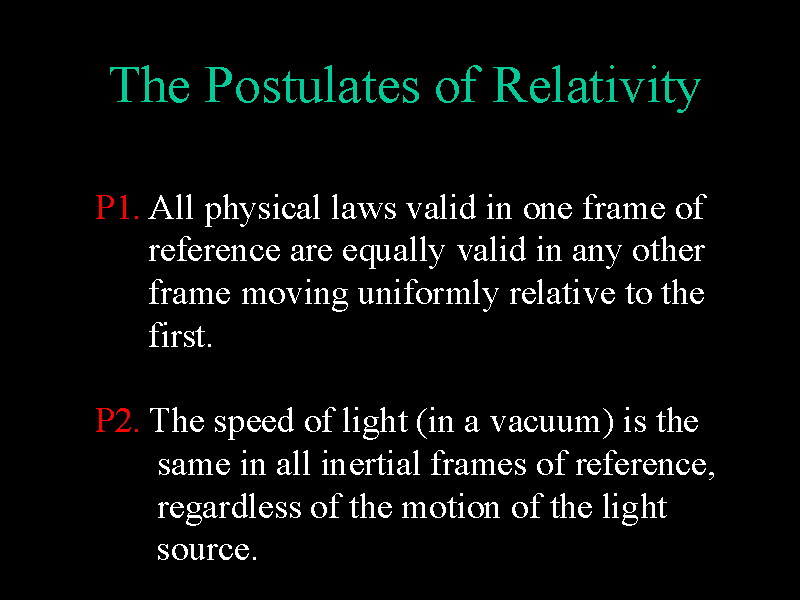Einstein’s Postulates:
With two deceptively simple postulates and a careful consideration of how measurements are made, Einstein produced the theory of special relativity.
1. The Principle of Relativity:
The laws of physics are the same and can be stated in their simplest form in all inertial frames of reference.This postulate relates to reference frames. It says that there is no preferred frame and, therefore, no absolute motion.
Physical laws are the same in all frames of reference. That is; any event within a portion of space (a frame) can be specified by three spatial dimensions (east-west, north-south, up-down) and one temporal dimension (time). Also, the laws that apply to us in everyday circumstances (such as Newton’s laws) also apply within each frame of reference.
2. The Principle of Invariant Light Speed:
The speed of light c is a constant, independent of the relative motion of the source and observer.
The speed of light is constant. By this it is meant that in a vacuum, such as in space, the speed of light is always the same, regardless of the speed of someone observing it.
The laws of electricity and magnetism predict that light travels at c = 2.998×108 m/s in a vacuum, but they do not specify the frame of reference in which light has this speed. Physicists assumed that there exists a stationary medium for the propagation of light, which they called “luminiferous aether. “
Michelson and Morley Attempt:
In 1887, Michelson and Morley attempted to detect the relative motion of the Earth through the stationary luminiferous aether, but their negative results implied the speed of light c is independent of the motion of the source relative to the observer. Einstein accepted the result of the experiment and incorporated it in his theory of relativity.
This postulate might sound easy to accept, but it is rather counter-intuitive. Imagine that you can throw a baseball at a speed v (relative to you). If you are on a train moving
at a speed V and throw a ball in the direction of the train’s movement, the baseball will travel at a speed v+V for an observer stationary on the ground.
Now, instead of a baseball, let’s say you have a laser pointer. You turn on the laser pointer while you are on a moving train. What would be the speed of light from the laser pointer for a stationary observer on the ground? Our intuition says that it should be c+V. However, Einstein says that it should be only c!

Conceptual Questions
-
Which of Einstein’s postulates of special relativity includes a concept that does not fit with the ideas of classical physics? Explain.
-
Is Earth an inertial frame of reference? Is the Sun? Justify your response.
-
When you are flying in a commercial jet, it may appear to you that the airplane is stationary and the Earth is moving beneath you. Is this point of view valid? Discuss briefly.
